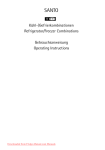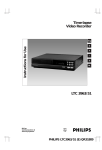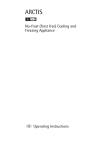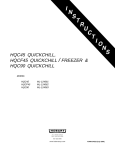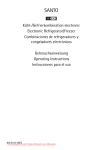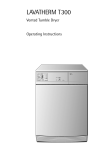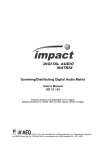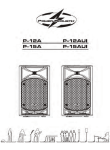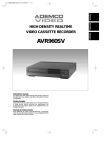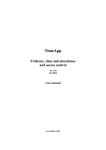Download AEG Santo 3030 DT Operating instructions
Transcript
SANTO Kühl-/Gefrierkombinationen Refrigerator/Freezer Combinations Combinés réfrigérateur/congélateur Gebrauchsanweisung Operating Instructions Notice d’utilisation Downloaded from Fridge-Manual.com Manuals Dear customer, Before placing your new refrigerator/freezer into operation please read these operating instructions carefully. They contain important information for safe use, for installation and for care of the appliance. Please keep these operating instructions for future reference. Pass them on to possible new owners of the appliance. Notes which are important for your safety or for the proper functioning of the appliance are stressed with a warning triangle and/ or with signal words (Warning!, Caution!, Attention!). Please observe the following carefully. This symbol guides you step by step in the operation of the appliance. Supplementary information regarding operation and practical applications of the appliance appear after this symbol. Tips and notes concerning economical and environmentally sound use of the appliance are marked with the cloverleaf. Explanations of the technical terminology used in the operating instructions can be found at the end in the section "Technical Terminology". The operating instructions contain instructions for the correction of possible malfunctions by the user in the section "What to do if...". If these instructions should not be sufficient, please contact your local Service Force Centre. Printed on paper manufactured with environmentally sound processes. he who thinks ecologically acts accordingly ... Downloaded from Fridge-Manual.com Manuals 25 Contents Safety . . . . . . . . . . . . . . . . . . . . . . . . . . . . . . . . . . . . . . . . . . . . . . . . . . . . . . 28 Disposal . . . . . . . . . . . . . . . . . . . . . . . . . . . . . . . . . . . . . . . . . . . . . . . . . . . . . 30 Appliance Packaging Information . . . . . . . . . . . . . . . . . . . . . . . . . . . . . . . . 30 Disposal of old Appliances . . . . . . . . . . . . . . . . . . . . . . . . . . . . . . . . . . . . . . . 30 Appliance Transport . . . . . . . . . . . . . . . . . . . . . . . . . . . . . . . . . . . . . . . . . . . 30 Remove transport safeguard . . . . . . . . . . . . . . . . . . . . . . . . . . . . . . . . . . . . 31 Installation . . . . . . . . . . . . . . . . . . . . . . . . . . . . . . . . . . . . . . . . . . . . . . . . . . Installation Location . . . . . . . . . . . . . . . . . . . . . . . . . . . . . . . . . . . . . . . . . . . The refrigerator/freezer needs air . . . . . . . . . . . . . . . . . . . . . . . . . . . . . . . . . Appliance Alignment . . . . . . . . . . . . . . . . . . . . . . . . . . . . . . . . . . . . . . . . . . Electrical Connection . . . . . . . . . . . . . . . . . . . . . . . . . . . . . . . . . . . . . . . . . . 31 31 32 32 32 Changing the opening direction of the doors . . . . . . . . . . . . . . . . . . . . . . 33 Appliance Description . . . . . . . . . . . . . . . . . . . . . . . . . . . . . . . . . . . . . . . . . 34 View of Appliance . . . . . . . . . . . . . . . . . . . . . . . . . . . . . . . . . . . . . . . . . . . . . 34 Prior to Initial Start-Up . . . . . . . . . . . . . . . . . . . . . . . . . . . . . . . . . . . . . . . . 35 Starting up and temperature regulation . . . . . . . . . . . . . . . . . . . . . . . . . . 35 Switching the Appliance Off . . . . . . . . . . . . . . . . . . . . . . . . . . . . . . . . . . . . 36 Opening the Freezer Compartment Door . . . . . . . . . . . . . . . . . . . . . . . . . . 36 Interior Accessories . . . . . . . . . . . . . . . . . . . . . . . . . . . . . . . . . . . . . . . . . . . 37 Storage Shelves/Storage Racks . . . . . . . . . . . . . . . . . . . . . . . . . . . . . . . . . . . 37 Variable Inner Door . . . . . . . . . . . . . . . . . . . . . . . . . . . . . . . . . . . . . . . . . . . . 37 Proper Storage. . . . . . . . . . . . . . . . . . . . . . . . . . . . . . . . . . . . . . . . . . . . . . . . 38 Freezing . . . . . . . . . . . . . . . . . . . . . . . . . . . . . . . . . . . . . . . . . . . . . . . . . . . . . 39 Frozen Storage . . . . . . . . . . . . . . . . . . . . . . . . . . . . . . . . . . . . . . . . . . . . . . . 40 Preparation of Ice Cubes . . . . . . . . . . . . . . . . . . . . . . . . . . . . . . . . . . . . . . . 40 Defrosting . . . . . . . . . . . . . . . . . . . . . . . . . . . . . . . . . . . . . . . . . . . . . . . . . . . 40 The refrigerator is defrosted automatically . . . . . . . . . . . . . . . . . . . . . . . . . 40 Freezer Compartment Defrosting . . . . . . . . . . . . . . . . . . . . . . . . . . . . . . . . . 40 Cleaning and Care. . . . . . . . . . . . . . . . . . . . . . . . . . . . . . . . . . . . . . . . . . . . . 42 Inside of appliance . . . . . . . . . . . . . . . . . . . . . . . . . . . . . . . . . . . . . . . . . . . . 42 Outside of appliance . . . . . . . . . . . . . . . . . . . . . . . . . . . . . . . . . . . . . . . . . . . 43 Downloaded from Fridge-Manual.com Manuals 26 Contents Energy Saving Tips . . . . . . . . . . . . . . . . . . . . . . . . . . . . . . . . . . . . . . . . . . . . 43 What to do if ... . . . . . . . . . . . . . . . . . . . . . . . . . . . . . . . . . . . . . . . . . . . . . 44 Correcting Malfunctions . . . . . . . . . . . . . . . . . . . . . . . . . . . . . . . . . . . . . . . . 44 Replace light bulb . . . . . . . . . . . . . . . . . . . . . . . . . . . . . . . . . . . . . . . . . . . . . 45 Customer Service . . . . . . . . . . . . . . . . . . . . . . . . . . . . . . . . . . . . . . . . . . . . . 46 Noises during Operation . . . . . . . . . . . . . . . . . . . . . . . . . . . . . . . . . . . . . . . 46 Regulations, Standards, Guidelines . . . . . . . . . . . . . . . . . . . . . . . . . . . . . . 47 Technical Terminology . . . . . . . . . . . . . . . . . . . . . . . . . . . . . . . . . . . . . . . . . 47 Downloaded from Fridge-Manual.com Manuals 27 Safety The safety of our refrigerators/freezers is in accordance with recognised technological standards and appliance safety legislation. We nevertheless feel that it is important to acquaint you with the following safety guidelines: Use for Intended Purpose • The refrigerator/freezer is intended for household use. It is suited for the refrigeration, freezing and frozen storage of foods as well as the preparation of ice. If the appliance is used for purposes other than those intendet or used incorrectly, no liability can be accepted by the manufacturer for any damage that may be caused. • Alterations or changes to the refrigerator/freezer are not permitted for reasons of safety. • If you use the refrigerator/freezer in a commercial application or for purposes other than the refrigeration, freezing or frozen storage of foods, please observe all valid legal regulations for your application. Prior to initial start-up • Check the refrigerator/freezer for transport damage. Do not under any circumstances connect a damaged appliance! Please contact your supplier in the event of damage. Refrigerant The refrigerant isobutane (R600a) is contained within the refrigerant circuit of the appliance, a natural gas with a high level of environmental compatibility, which is nevertheless flammable. • During transportation and installation of the appliance, be certain that none of the components of the refrigerant circuit become damaged. • If the refrigerant circuit should become damaged: – avoid open flames and sources of ignition; – thoroughly ventilate the room in which the appliance is situated. Safety for Children • Packaging materials (e.g. films, styrofoam) can be dangerous for children. Danger of suffocation! Keep packaging materials away from children! • Before disposing of old appliances make them inoperable. Remove plug from mains, sever the power cable, remove or destroy any snap or latch closures. This eliminates the danger that playing children lock themselves into the appliance (danger of suffocation!) or place themselves into other life-endangering situations. Downloaded from Fridge-Manual.com Manuals 28 Safety • Children often do not recognise the dangers involved with household appliances. Please provide for the necessary supervision and do not allow children to play with the appliance! Daily Operation • Containers with flammable gases or fluids can develop leaks through contact with the cold. Danger of explosion! Do not store containers with flammable substances, such as aerosol cans, refill cartridges for cigarette lighters etc. in the refrigerator/freezer. • Bottles and cans may not be placed in the freezer compartment. They can burst when the contents freeze - or even explode if the contents contain carbonic acid! Never place sodas, juices, beer, wine, champagne etc. into the freezer compartment. Exception: Spirits with high alcohol content may be stored in the freezer compartment. • Do not place ice cream or ice cubes directly from the freezer compartment into the mouth. Very cold ice can freeze to the lips or tongue and cause injury. • Never touch frozen goods with wet hands. Hands can freeze to the goods. • Do not operate any electrical appliances in the refrigerator/freezer (e.g. electric ice cream makers, mixers etc.). • Before cleaning the appliance switch off and remove the plug from the mains, or switch off or turn out the circuit breaker or fuse. • When unplugging always pull the plug from the mains socket, do not pull on the cable. In case of malfunction • If a malfunction should occur at the appliance, refer first to the section "What to do if ..." in these operating instruction. If the instructions in this section are not sufficient, do not undertake any further work on your own. • Refrigerators/feezers may only be repaired by trained personnel. Repairs carried out by untrained personnel can lead to substantial danger. Please contact your dealer or our customer service department for repairs. Downloaded from Fridge-Manual.com Manuals 29 Disposal Appliance Packaging Information All materials are environmentally sound! They can be dumped or burned at an incinerating plant without danger! About the materials: The plastics can be recycled and are identified as follows: >PE< for polyethylene, e.g. the outer covering and the bags in the interior. >PS< for polystyrene foam, e.g. the pads, which are all free of chlorofluorocarbon. Disposal of old Appliances For environmental reasons, refrigeration appliances must be disposed of properly. This applies to your old appliance, and - at the end of its service life - for your new appliance as well. Warning! Before disposing of old appliances make them inoperable. Remove plug from mains, sever the power cable, remove or destroy any snap or latch closures. This eliminates the danger that playing children lock themselves into the appliance (danger of suffocation!) or place themselves into other life-endangering situations. Disposal: • The appliance may not be disposed of with domestic waste or bulky refuse. • The refrigerant circuit, especially the heat exchanger at the back of the appliance, may not be damaged. • Information concerning collection schedules or locations can be obtained from the local disposal authorities or town hall. Appliance Transport Two persons are required for transport of the appliance. In order to push the appliance into its final position, press carefully at the top of the upper door and tip the appliance back slightly. The weight is then transferred to the back wheels and the appliance can be easily pushed. Downloaded from Fridge-Manual.com Manuals 30 Remove transport safeguard The appliance as well as interior accessory parts are safeguarded for transport. Remove all tape and pads from the interior of the appliance. Installation Installation Location The appliance should be set up in a well ventilated, dry room. Energy use is affected by the ambient temperature. The appliance should therefore – not be exposed to direct sunlight; – not be installed next to radiators, cookers or other sources of heat; – only be installed at a location whose ambient temperature corresponds to the climate classification, for which the appliance is designed. The climate classification can be found on the serial plate, which is located at the left on the inside of the appliance. The following table shows which ambient temperature is correct for each climate classification: Climate classification SN for an ambient temperature of +10 bis +32 °C N +16 bis +32 °C ST +18 bis +38 °C T +18 bis +43 °C If installation next to a source of heat is unavoidable, the following minimum clearances must be maintained at the sides of the appliance: – for electric cookers 3 cm; – for oil and coal fired ranges 30 cm. If these clearances cannot be maintained a heat insulating pad is required between the cooker and the refrigeration appliance. Downloaded from Fridge-Manual.com Manuals 31 The refrigerator/freezer needs air Air is fed under the door through the vent slots in the base and is exhausted upwards along the back wall. To ensure proper air circulation never cover or alter the vent openings. Attention! If the appliance is installed under, for example, a hanging cabinet, a clearance of at least 5 cm between the top of the appliance and the cabinet above it must be maintained. Appliance Alignment The appliance must have a solid, level footing. Please compensate for unevenness in the floor by turning the two adjustable feet at the front in or out. Electrical Connection A properly installed socket outlet with earthing contact is required for electrical connection. Electrical fuse protection must be of at least 10 ampere. If the outlet socket is no longer accessible after installation of the appliance, appropriate measures must be taken during electrical installation to assure that the appliance can be disconnected from the mains (e.g. fuse, circuit breaker, non-operate current safety-switch or the like, with a contact opening of at least 3 mm). Before initial start-up, refer to the appliance serial plate to ascertain if supply voltage and current values correspond with those of the mains at the installation location. e.g.: AC 230 V 50 Hz or 230 V~50 Hz (i.e. 230 volts alternating current, 50 Hertz) The serial plate is inside the appliance at the left. Downloaded from Fridge-Manual.com Manuals 32 Changing the opening direction of the doors Before carrying out any operations, remove the plug from the power socket. To change the opening direction of the door, proceed as follows: 1. Remove the upper hinge and the upper support taking care for the upper door not to fall off ; 2. remove the upper door; 3. unscrew the middle hinge. Unscrew the plastic plugs located on the opposite side of the central hinge and introduce them in the holes occupied before by the hinge; 4. remove the lower door; 5. pull off the ventilation grille which is fixed by two screws; 6. remove the bottom hinge by unscrewing its fixing screws; 7. using a 12 mm spanner, unscrew the hinge pin and reassemble it on the opposite side of the hinge; 8. adjust the level of the appliance by screwing out the adjustable foot, or feet, at the bottom of the cabinet using your fingers or a tool; 9. reassemble the lower hinge on the opposite side, using the screws previously removed. Slide the hole cover out of the ventilation grille by pushing it in the direction of the arrow and reassemble it on the opposite side; 10. refit the ventilation grille , fixing the screws; 11. reassemble the lower door; 12. reassemble the middle hinge on the opposite side; 13. replace the upper door. 14. In your documentation bag you will find the upper hinge and the upper support necessary to make the reversibility. Please mount them in their relevant place. 15. Depending on the model: Model with bar handle Dismantle the handles and reassemble them on the opposite side. Cover the holes with the plastic lids that were situated where the handles are presently. Downloaded from Fridge-Manual.com Manuals 33 m Warning: After having reversed the opening direction of the doors check that all the screws are properly tightened and that the magnetic seal adheres to the cabinet. If the ambient temperature is cold (i.e. in Winter), the gasket may not fit perfectly to the cabinet. In that case, wait for the natural fitting of the gasket or accelerate this process by heating up the part involved with a normal hairdrier. Appliance Description View of Appliance (various models) Temperature regulator and light switch 7 Butter and cheese compartment with lid 8 1 9 2 6 3 Door storage compartment Bottle compartment Fruit and vegetable drawers Shelves Freezer compartment (for storage and freezing) 5 4 Downloaded from Fridge-Manual.com Manuals 34 Freezer door storage compartment (2 stars, only for storage at -12 °C) Serial plate Prior to Initial Start-Up Before connecting the appliance to the mains and putting it into operation for the first time, leave the appliance to stand for 30 minutes if was transported upright. After transport on its side, the appliance must be left to stand for 4 hours before putting it into operation. This is necessary to allow the oil to flow back into the compressor. Otherwise the compressor may be damaged. clean the appliance interior and all accessories prior to initial Please start-up (see section: "Cleaning and Care"). Starting up and temperature regulation Refrigerator and freezer compartments can not be operated independently of one another. Insert plug into mains socket. The temperature regulator is on the right side in the refrigerator compartment. It is also the ON/OFF-switch. Position "0" means: Cooling off Position "1"means: Highest interior temperature (warmest setting) Position "6" means: Lowest interior temperature (coldest setting) Recommended settings: For normal use: position "3" - "4"; Turn the temperature regulator to the desired setting. The compressor starts and then runs automatically. Goods to be refrigerated can be loaded immediately after switching on, because the storage temperature in the refrigerator is quickly reached. Important! Wait until the freezer compartment has reached a temperature of –18 °C before storing frozen food. Note: From a food science point of view, +5 °C for the refrigerator compartment and -18 °C for the freezer compartment should be considered cold enough as a storage temperature. Downloaded from Fridge-Manual.com Manuals 35 The following effects are of significance in respect of the interior temperature: – Ambient temperature; – Quantity and temperature of the food stored; – Frequency with which the door is opened and how long it is left open. Switching the Appliance Off Refrigerator and freezer compartments can not be switched off independently of one another. To switch off, turn the temperature regulator to position "0". If the appliance is to be removed from service for a lengthy period: Turn the temperature regulator to position "0". Unplug the appliance, or pull or unscrew the fuse. Defrost freezer compartment and clean thoroughly (see section: "Cleaning and Care"). Leave doors open after defrosting to avoid accumulation of odours. Opening the Freezer Compartment Door If the freezer compartment door is closed when the appliance is in operation, it is possible that it cannot be immediately opened again, because a vacuum occurs in the freezer compartment which holds the door closed until pressure has been equalised. The door can be opened again after several minutes. Downloaded from Fridge-Manual.com Manuals 36 Interior Accessories Storage Shelves/Storage Racks Depending on the model, your appliance is equipped with either glass storage shelves or storage racks. A glass storage shelf must always remain inserted into the lower guide track above the fruit and vegetable trays, so that fruits and vegetable remain fresh longer. The remaining storage shelves can be adjusted to various heights: Pull the storage shelf forward and remove. Insert at a different height. Variable Inner Door The door compartments can be pulled up and removed, and inserted at other positions as needed. Moisture regulator There is an adjustable air grille in front of the shelf above the fruit and vegetable compartments. The opening in the ventilation slots can be adjusted with the slider. Right slider: Ventilation slots opened. With the ventilation slots open, more air circulation results in a lower air moisture content in the fruit and vegetable compartments. Left slider: Ventilation slots closed. When the ventilation slots are closed, the natural moisture content of the food in the fruit and vegetable compartments is preserved for longer. Downloaded from Fridge-Manual.com Manuals ON 37 Proper Storage Different temperature zones exist within the refrigerator due to the laws of physics. The coldest zone is at the bottom storage shelf above the fruit and vegetable trays. The warmer zones are found at the uppermost storage shelves and in the door compartments. The arrangement example shows at which places in the refrigerator suitable temperatures for various types of foods exist. The freezer door storage compartment (2 stars) serves only for storage purposes at -12 °C (storage time 2-3 weeks, depending on food). Tip: Foods should always be packaged or covered in the refrigerator, in order to avoid odour or flavour contamination to other refrigerated goods. The following are suited for pakkaging: – plastic bags and wraps of polyethylene; – plastic containers with lids; – special plastic covers with elastic seals; – aluminium foil. Downloaded from Fridge-Manual.com Manuals 38 Freezing Attention! • Before foods are frozen, the actual temperature in the freezer compartment must be -18°C or colder. • Please observe indicated freezing capacity on the serial plate. The freezing capacity represents the maximum amount of fresh goods that can be frozen within 24 hours. If you freeze goods on several days, one after the other, freeze amounts equal to 2/3 to 3/4 of the capacity indicated on the serial plate. • Thawed foods which have not been processed further (cooked into meals) may not under any circumstances be frozen a second time. All foods must be packed air tight prior to freezing, so that they do not dry out or lose their flavour, and so that no flavour contamination of other frozen goods occurs. Caution! Do not touch frozen goods with wet hands. Hands can freeze to the goods. Place packaged foods in the freezer compartment. Unfrozen goods may not come into contact with already frozen goods, otherwise the frozen goods may start to thaw. Tips: • – – – • The following are suited for the packaging of frozen goods: freezer bags and polyethylene wraps; special cans for frozen goods; extra-thick aluminium foil The following are suited for sealing bags and wraps: plastic clips, rubber bands or adhesive tape. • Press air out of bags and wraps before sealing, because air encourages drying of frozen goods. • Make flat packages, because these freeze more quickly. • Do not fill cans for frozen goods to the brim with liquid or paste-like goods, because liquids expand during freezing. Note for inspection authorities: Batch plans for the determination of freezing performance or warm-up time can be requested directly from the manufacturer. Downloaded from Fridge-Manual.com Manuals 39 Frozen Storage Attention! Before initial loading of the freezer compartment with previously frozen goods, the required storage temperature of -18°C must be reached. The freezer door storage compartment (2 stars) serves only for storage purposes at -12 °C. Storage time: 2-3 weeks, depending on food. • Load freezer compartment only with packaged frozen goods, so that they do not dry out or lose their flavour, and so that no flavour contamination of other frozen goods can occur. • Please observe maximum storage times and expiry dates of frozen goods. Preparation of Ice Cubes freezer is equipped with a Your specific holder in order to place the ice cube tray you will find inside your appliance. (see figure) Fill ice cube tray 3/4 full with cold water and place in the freezer com-partment and allow to freeze. To remove the finished ice cubes twist the ice cube tray or hold under running water for a short time. Attention! Do not, under any circumstances, free an ice tray which is frozen to the appliance with pointed or sharp edged objects. Use a spoon-handle or similar object. Defrosting The refrigerator is defrosted automatically The integrated evaporator on the rear wall of the refrigerator compartment is defrosted fully automatically. The water collects in the discharge trough at the back wall of the refrigerator, and is fed through the discharge opening in the catch tray at the compressor where it is evaporated. Downloaded from Fridge-Manual.com Manuals 40 Defrosting Freezer Compartment Defrosting Moisture is precipitated in the form of white frost in the freezer compartment during operation and when the door is opened. Remove this white frost from time to time with a soft plastic scraper, e.g. a dough scraper. Do not under any circumstances use hard or pointed objects for this purpose. The appliance should be defrosted when the thickness of the white frost has reached about 4 mm; but at least once a year in any case. A convenient time for defrosting is any time when the appliance is empty, or only minimally loaded. Warning! • Do not use electrical heating appliances or any other mechanical or artificial devices to speed up the defrosting process, with the exception of those recommended in these operating instructions. • Do not use defrosting sprays, because they may be health endangering and/or contain substances damaging to plastics. Caution! Do not touch frozen goods with wet hands. Hands can freeze to the goods. Remove frozen goods, pack them in several layers of newspaper, cover them and store them in a cool place, e.g. in a refrigerator. Switch off the appliance and remove plug from the mains, or switch off or turn out the circuit breaker or the fuse. After defrosting thoroughly clean the freezer interior, as well as interior accessories (see section: "Cleaning and Care"). Downloaded from Fridge-Manual.com Manuals 41 Cleaning and Care For hygienic reasons the appliance interior, including interior accessories, should be cleaned regularly. Warning! • The appliance may not be connected to the mains during cleaning. Danger of electrical shock! Before cleaning switch the appliance off and remove the plug from the mains, or switch off or turn out the circuit breaker or fuse. • Never clean the appliance with a steam cleaner. Moisture could accumulate in electrical components, danger of electrical shock! Hot vapours can lead to the damage of plastic parts. • The appliance must be dry before it is placed back into service. Attention! • Ethereal oils and organic solvents can attack plastic parts, e. g. – lemon juice or the juice from orange peals; – butyric acid; – cleansers which contain acetic acid. Do not allow such substances to come into contact with appliance parts. • Do not use any abrasive cleansers. Inside of appliance Defrost freezer compartment before cleaning (see section: "Defrosting“). off the appliance and remove plug from the mains, or switch off Switch or turn out the circuit breaker or the fuse. Clean the appliance and the interior accessories with a cloth and lukewarm water. Commercially available dish washing detergents may also be used. After cleaning wipe with fresh water and rub dry. Check the water discharge opening at the back wall of the refrigerator. A clogged water discharge opening can be freed with the help of a wire. Downloaded from Fridge-Manual.com Manuals 42 Outside of appliance Steel surface: For cleaning of the steel surface you can use cleaning agent for steel usual in the trade. Thouse cleaning agents create a protection against fingerprints as well. Warning: When using this product, it is necessary to avoid the contact with plastic material because of degradation. Painted surface: Clean the appliance with a cloth and lukewarm water. Commercially available dish washing detergents may also be used. After cleaning wipe with fresh water and rub dry. Accumulation of dust at the condenser reduces cooling performance and increases energy consumption. For this reason carefully clean the condenser at the back of the appliance once a year with a soft brush or a vacuum cleaner. After everything is dry place appliance back into service. Energy Saving Tips • Do not install the appliance near cookers, radiators or other sources of warmth. High ambient temperatures cause longer, more frequent operation of the compressor. • Ensure sufficient air circulation and exhaust at the appliance base and at the back wall of the appliance. Never cover air vent openings. • Do not place warm foods into the appliance. Allow warm foods to cool first. • Only leave door open as long as necessary. • Do not set temperature any colder than necessary. • Place frozen goods into the refrigerator for thawing. Cold from frozen goods is thus used for cooling in the refrigerator. • Always keep the condenser at the back of the appliance clean. Downloaded from Fridge-Manual.com Manuals 43 What to do if ... Correcting Malfunctions Perhaps a malfunction has been caused by a minor error, which you can correct yourself with the help of the following instructions. Do not attempt any further repairs if the following instructions do not help in each specific case. Warning! Refrigerators/freezers may only be repaired by trained personnel. Repairs carried out by untrained personnel can lead to substantial danger for the user. Please contact your dealer or our customer service department for repairs. Malfunction Appliance does not function, green stand-by display is not lit. Possible cause Remedy Appliance is not switched on. Switch appliance on. Mains plug is not inserted or is loose. Insert mains plug. Fuse has blown or is defec- Check fuse, replace if tive. necessary. Mains socket is defective. Mains malfunctions are to be corrected by an electrician. Temperature is not properly Please refer to the section adjusted. "Temperature Adjustment". The refrigerator and/or freezer compartment temperature is insufficient. Interior illumination does not function. Door was open for a long time. Only leave the door open as long as necessary. Within the last 24 hours a large quantity of warm foods were loaded. Turn to colder setting. Appliance is next to a source of warmth. Please refer to the section "Installation Location". Light bulb is defective. Please refer to "Replace Light Bulb" in this section. Downloaded from Fridge-Manual.com Manuals 44 Malfunction Large accumulation of frost in the appliance, perhaps also at the door seal. Unusual noises. The compressor does not start immediately after changing the temperature setting. Possible cause Door is not properly sealed Remedy seal with a hand-held hair dryer at those points which are not airtight (no warmer than approx. 50°C). At the same time, shape the warmed door seal by hand, so that it is again properly seated. Appliance is not level. Readjust the front levelling feet. Appliance is in contact with wall or other objects. Push appliance away a short distance. A part at the back of the appliance, e.g. a tube, is in contact with another appliance part or the wall. Bend this part away carefully if necessary. This is normal, no error has occurred. Carefully warm the door The compressor starts after a period of time. Replace light bulb Warning! Danger of electrical shock! Before replacing the light bulb switch appliance off and remove the mains plug, or switch off or turn out the circuit breaker or fuse. Light bulb specifications: 220-240 V, max. 15 W, fitting: E 14 To switch the appliance off turn the temperature regulator to position "0". Unplug the mains plug. To change the light bulb, pull out the xrew “Y” and then remove the protective cover “X”. Change the defective light bulb. Refit the light bulb cover. Downloaded from Fridge-Manual.com Manuals 45 Customer Service If you cannot find the remedy for a malfunction in these operating instructions, please contact your dealer or our customer service department. Addresses and telephone numbers are listed in the accompanying booklet "Guarantee Conditions/Customer Service Locations". Selective ordering of replacement parts can save unnecessary travel and costs. For this reason always provide the following appliance information: • Model Name • Model Number (PNC) • Serial Number (S-No.) This information can be found on the serial plate in the interior at the left of the appliance. We recommend that you enter this information here, so that it is handy if needed. Note: The customer bears the costs of unjustified customer service calls even during the guarantee period. Noises during Operation The following noises are characteristic of refrigeration appliances: • Clicks Whenever the compressor switches on or off, a click can be heard. • Humming As soon as the compressor is in operation, you can hear it humming. • Bubbling/Splashing When refrigerant flows into thin tubes, you can hear bubbling or splashing noises. Even after the compressor has been switched off, this noise can be heard for a short time. Downloaded from Fridge-Manual.com Manuals 46 Regulations, Standards, Guidelines This appliance was designed for household use and was manufactured in accordance with the appropriate standards. The necessary measures in accordance with appliance safety legislation regulations (GSG), accident prevention regulations for refrigeration appliances (VBG 20) and the regulations of the German Society of Electrical Engineers (VDE) were observed in the manufacture of this appliance. The refrigerant circuit has been checked for leaks. This appliance is in accordance with the following EU guidelines: – 73/23/EWG dated 19 February 1973 - low voltage guidelines. – 89/336/EWG dated 3 May 1989 (including guideline change notice 92/31/EWG) - EMV guideline Technical Terminology • Refrigerant Fluids, which are used for refrigeration are called refrigerants. They have a relatively low boiling point; so low, that the warmth of foods in the refrigeration appliance can cause them to boil or vaporise. • Refrigerant circuit Sealed circulation system, in which the refrigerant is found. The refrigerant circuit consists for the most part of an evaporator, a compressor, a condenser and tubing. • Evaporator The refrigerant is evaporated in the evaporator. This warmth is withdrawn from the appliance interior, which is thus cooled. Like all fluids, refrigerants require warmth in order to be evaporated. For this reason the evaporator is located in the appliance interior or installed with foam directly behind the interior wall, and is thus invisible. • Compressor The compressor looks like a small bin. It is powered by an electric motor and is housed at the back in the base of the appliance. It is the task of the compressor to withdraw vaporous refrigerant from the evaporator, to compress it and feed it to the condenser. • Condenser The condenser is usually in the form of a grid. Compressed refrigerant from the compressor is liquefied in the condenser. Thus warmth is released, which is given off into the surrounding air at the surface of the condenser. The condenser is therefore outside of the appliance, usually at the back. Downloaded from Fridge-Manual.com Manuals 47 AEG Hausgeräte GmbH Postfach 1036 D-90327 Nürnberg http://www.aeg.hausgeraete.de © Copyright by AEG 214.3661.88 05/04 Downloaded from Fridge-Manual.com Manuals Änderungen vorbehalten Subject to change without notice Sous réserve de modifications

























